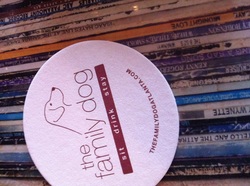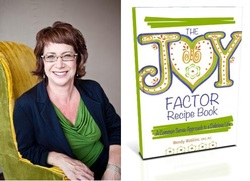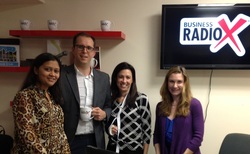 The April-May culinary issue of Atlanta Tastemaker features 3 articles written by yours truly. I enjoyed writing each of them and hope you enjoy reading them just as well. There's Chocolate Madness on pg45, Drink,Snack,Share on pg47 and a review of Family Dog on pg51. Just click on the image above and you can head to an issuu link to check out the magazine. I really enjoyed the review of Family Dog. It was a preview of the new Spring brunch menu the restaurant was introducing and the chef came to our table with every dish to describe the flavors and ingredients. Loved it!
0 Comments
 A Joy Strategist from Decatur GA, Wendy Watkins, 50, is the author of The Joy Factor Recipe Book – A Common Sense Approach to a Delicious Life – a 202-page book published in May 2012 and available in print on Amazon. A Certified Professional Co-Active Coach from The Coaches Training Institute, she is still attending the School of Life! The book is a great inspirational and motivational personal development tool. Connect with Wendy on Facebook, Twitter, LinkedIn, YouTube or read more about her work and her book on her website. Wendy shares in-depth about her experience writing her first book. “I have always been a personal development junkie who loves food, so sharing my message on how to raise your Joy Factor in a “cookbook” format was unique and fun. When I became a Professional Coach in 2000, I knew I had an important message to share with the world; however, I was unclear on exactly what format it would take. I was asked to speak at a conference in New Orleans in 2008 and the concept of raising your Joy Factor became my topic. As I fine-tuned this concept of tapping into increased joy to manifest a desirable life, I realized this was the message I was to write about. I heard myself utter the words, “I am going to write a book”, and the process began.” So what was the process like? “My first documents on my computer for this project were dated early 2009. Most of the information came from my life experience, as well as my clients’ journeys. For the majority of my adult life, I looked for joy outside of myself. I call this my sex, drugs and rock and roll era. In late 2005, I succumbed to the fact that I was a highly functioning prescription drug addict. The umbrella of shame that I lived under stopped me from experiencing true joy. When I stopped abusing drugs in January 2006, I was able to examine my journey a bit more clearly. In 2007, the quest to look at what brought me sustainable joy began and the ingredients for the Joy Factor started to become well-defined. The way the principles of attraction work, the more I put my attention on this notion of sustainable joy, the more I attracted clients who wanted to be in this type of conversation. My Joy Factor website launched and I blogged about these ingredients. There are 20 contributors in the book - I call them my Joy Posse. They all share recipes that use the ingredients I share with people to raise their Joy Factor. Their entries come from the blog as well as other sources.” And the next steps were… “I hired a designer and editor to help me put the finishing touches on the book in late 2011. It was published in Spring 2012. There were times when that felt like the longest three years of my life and other times, it seemed to fly by. Staying focused on the project was a bit challenging. First, when you are working and writing, it can be challenging to make the book a priority. That first year I really worked on creating sacred space to write, taking retreats and spending time at gorgeous locations in the Southeast. The second year, I was feeling focused and enthusiastic. I entered a contest to be The Next Top Self-Help Author. My optimism was high - I was going to win the contest! It was a real blow when I did not make the first cut. That was March 2011. After that, I did not touch the manuscript for six months. I realized that I was writing this book from my ego, my desire to be famous and to be on Oprah. I did lots of soul-searching and shifted the format of my book from a very significant “this is my story” type of book, to its present format which is much more fun and easy to read - more like me! After I figured that out, I began writing again and finished the project in eight months.” On her schedule and others who helped in the venture. “At first, I did not have a true schedule. I waited until the creativity struck me or I retreated somewhere to write. When I decided to finish the book, I committed to awaking each day at 5:30 a.m. to be able to write a few hours before I began working with clients. I did that every day for many months. Yes, as I mentioned, I had my Joy Posse. They were collaborators on my blog. I looked at some of their posts and put the appropriate ones in the book. I also invited others to write a “recipe” for the book. There are also at least 20 pieces of original art that were created for the book. I had both a designer and editor help me put all of the pieces of the puzzle together. I could not have completed the project without them.” What about the publishing process? “Initially, I was hoping to receive an offer from a publishing company. After the debacle with the contest, I decided to self-publish. It was important to me to use a local publisher, since I am a proponent of keeping business local. I gathered a few recommendations and made my choice with Booklogix in Alpharetta. They were wonderful in working with me and walking me through the publishing process.” The response to Wendy’s book has been great. “I had an amazing launch party at Cooks Warehouse in Decatur. It was the perfect way to introduce the book to the community. People comment that they enjoy that it is easy to read. They like that they can read it cover to cover, or open it at any point and get a tasty nugget to help them optimize their day. Many of my fans purchase the book as gifts after they read it. It is perfect for someone who loves personal development and food.” Marketing tips are on Wendy’s website and blog. “As soon as the book launched, I began putting attention on attracting speaking engagements. That has been the best way for me to market my book. I am getting ready to publish it digitally, so I can offer incentives for people to purchase—buy a copy of the book and receive the digital version for free or a special price.” Wendy’s Book is available locally in Decatur - it is at Eagle Eye Bookstore and Vivid Boutique. It is also available at City Lights Bookstore in Sylva, NC. Currently, Wendy is busy writing blog posts and articles. She is also working on a project that aligns perfectly with the book, called Simply Flourishing, and will have more details on that coming soon on her blog. To aspiring writers planning to publish in the future, her advice is, “Be clear on what you want to create, stay focused and take care of yourself throughout the process. Hire support to make the book exactly as you want it to be.” Thank you for your inspiring story Wendy, and hope many more will read your book and share their responses here! I enjoy connecting with people from diverse professional backgrounds. So if you are here and reading this then feel free to connect with me on LinkedIn and follow me on Twitter. The links are on the top right corner of my website and on every page so let's connect and see how we can help each other. I am always happy to help with an introduction if I can or a referral if you would like to connected to some of my professional contacts. If you have any specific requests, then feel free to email me through the contact form on my website and let's get talking!
Signed up with them few days ago so here is my profile on their website. Check it out, join me there, let me know your thoughts.
 With guest and hosts on Good Morning Atlanta! With guest and hosts on Good Morning Atlanta! I was a guest on the Good Morning Atlanta radio show a few days ago so here is a link to the page where you can click to listen to the radio podcast. Enjoy! That is one of the sections on Chris Guillebeau's World Domination Report, something I read from time to time to keep me charged and focussed. He is the author of The Art of Non-conformity, one of my all time fave books, I have it on my desk all the time. And clearly I am not what the title of this post is as can be observed below:
1. Accept what people tell you at face value - I am a sceptic, very hard for me to take anything you say at face value. 2. Don't question authority - Another one I have trouble with all the time. 3. Go to college because you are supposed to not because you want to learn something - Ended up having to do that as I lived with my parents at that time and that's what I had to do, but have not studied further since. and in my case, college was a waste of my time. 4. Go overseas once or twice in your life, to somewhere safe like England - been overseas multiple times with family and it was never England. 5. Don't try to learn another language, everyone else will eventually learn English - Grew up speaking English, Hindi, Tamil, Urdu, now learning French and eventually would like to learn Arabic and American Sign Language. 6. Think about starting your own business but never do it - Been there, done that. Had my business Ideas Are Us selling eco-friendly products from India since 2008, now winding down the operation a bit to focus on my business of writing and editing. 7. Think about writing a book but never do it - Already on this journey so there is no turning back. 8. Get the largest mortgage you qualify for and spend 30 years paying for it - No mortgages to report, whew! 9. Sit at a desk 40 hours a week for an average of 10 hours of productive work - I work from home for 20-30 hours a week on average and its all good productive work, even if I say so myself. 10. Don't stand out or draw attention to yourself - Sometimes yes and sometimes no. 11. Jump through hoops, check off boxes - Wait...what hoops? What boxes? Check out his book and website here! My question on page designing and copy editing has set off a serious discussion. This is on a LinkedIn group called Freelance Editing Network. Feel free to join in on the debate and share your thoughts here.
|
Categories
All
Archives
March 2023
|
